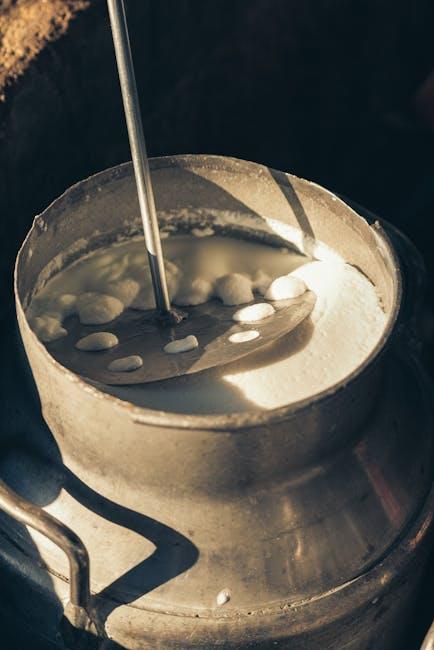In the realm of culinary exploration, few topics stir as much curiosity and debate as the consumption of raw milk. This age-old elixir, celebrated for its creamy richness and unprocessed nature, has found a new role in modern kitchens: the raw milk smoothie. As vibrant fruits and verdant greens whirl together with this unpasteurized ingredient, a question emerges from the frothy depths: Is it truly safe to indulge in this wholesome blend? In this article, we will navigate the intricate landscape of raw milk smoothies, examining both the tantalizing allure of their natural benefits and the potential risks that lie beneath their silky surface. Join us as we sift through the myths and realities, seeking clarity in the creamy swirl of this nutritional debate.
Understanding the Raw Milk Debate
When discussing the consumption of raw milk, it’s essential to consider both its potential benefits and risks. Advocates of raw milk claim it offers a richer flavor and higher nutritional value compared to its pasteurized counterpart. Some proponents argue that raw milk contains beneficial bacteria, enzymes, and vitamins that are often diminished during the pasteurization process. Additionally, raw milk enthusiasts believe it supports gut health and boosts the immune system.
On the other hand, health authorities warn about the risks associated with consuming raw milk. These concerns primarily revolve around the presence of harmful bacteria such as Salmonella, E. coli, and Listeria, which can lead to serious illness. Critics emphasize that the potential for contamination is significant, particularly for vulnerable populations like pregnant women, children, and those with weakened immune systems. The debate continues as consumers weigh the natural appeal of raw milk against these safety concerns. Here are some points to consider:
- Nutritional content: Raw milk is often lauded for its perceived higher nutritional profile.
- Safety concerns: The risk of bacterial infection remains a critical issue.
- Legal status: Raw milk sales are regulated differently across regions, affecting availability.
Nutritional Benefits and Risks of Raw Milk
Raw milk is often touted for its nutritional profile, which includes an array of vitamins, minerals, and beneficial enzymes that are sometimes diminished during the pasteurization process. Advocates of raw milk highlight its richness in vitamin A, vitamin D, calcium, and probiotics, which are believed to support digestive health and boost the immune system. The presence of natural enzymes like lactase can make it easier for some lactose-intolerant individuals to digest, potentially turning your smoothie into a nutrient powerhouse.
However, the consumption of raw milk comes with its share of risks. Without pasteurization, raw milk can harbor harmful bacteria such as Salmonella, E. coli, and Listeria, posing a significant health threat, particularly to vulnerable groups such as pregnant women, children, and the elderly. The Centers for Disease Control and Prevention (CDC) warns that these pathogens can lead to severe foodborne illnesses. While enthusiasts appreciate the unprocessed nature of raw milk, it’s crucial to weigh these potential risks carefully, especially when considering it as an ingredient in your favorite smoothie recipes.

Safe Practices for Preparing Raw Milk Smoothies
When crafting raw milk smoothies, it is essential to prioritize safety to enjoy the creamy richness without worry. Here are some key practices to ensure a safe and delightful experience:
- Source Responsibly: Always obtain raw milk from reputable farms that adhere to strict hygiene standards. Look for certifications or reviews that confirm their commitment to safety.
- Refrigerate Promptly: Keep raw milk chilled below 40°F (4°C) at all times. This reduces the risk of bacterial growth and preserves the milk’s natural flavors.
- Sanitize Equipment: Before use, thoroughly clean all blenders, knives, and utensils with hot, soapy water to eliminate any potential contaminants.
- Use Fresh Ingredients: Ensure all fruits, vegetables, and additional ingredients are fresh and washed properly to prevent introducing unwanted bacteria.
By following these guidelines, you can indulge in the unique taste of raw milk smoothies while maintaining peace of mind. Remember, safety is the first ingredient in every delicious blend.

Alternatives to Raw Milk for Your Smoothie
For those seeking a safer alternative to raw milk in their smoothies, there are a plethora of delicious and nutritious options available. Almond milk is a popular choice, offering a creamy texture and a subtle nutty flavor. It’s low in calories and enriched with vitamins like E and D. Coconut milk is another excellent option, especially for those who prefer a richer taste. It adds a tropical twist and provides healthy fats that can enhance the smoothie’s creaminess.
- Oat Milk: Perfect for those who enjoy a slightly sweet, earthy flavor. It’s high in fiber and can give your smoothie a thicker consistency.
- Soy Milk: A great source of protein, making it ideal for post-workout smoothies. It has a mild taste that blends well with most fruits and vegetables.
- Rice Milk: Offers a naturally sweet flavor and is a good choice for those with nut or soy allergies.
- Cashew Milk: Known for its creamy texture, it’s perfect for creating rich and velvety smoothies.
Each of these alternatives not only provides a safe substitute for raw milk but also brings its own unique flavor profile and nutritional benefits, ensuring your smoothies remain a delightful and healthful experience.
Final Thoughts
As we navigate the complex world of nutrition and wellness, the allure of raw milk smoothies presents both tantalizing possibilities and cautionary tales. Whether you find yourself drawn to their purported benefits or wary of their potential risks, the decision ultimately rests in your hands, guided by personal values and health priorities. As with any dietary choice, informed decisions are key. So, as you sip on your next smoothie, raw or otherwise, remember that knowledge is the best ingredient. Here’s to making choices that nourish both body and mind, one thoughtful sip at a time.




